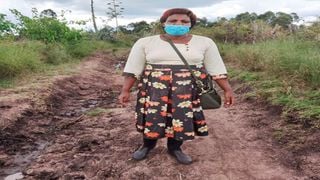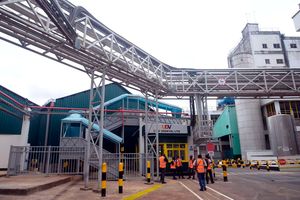
Mrs Magdalene Njoki Kimani during one of her long trips to deliver exams to KCSE candidates at Sosiana High School.
| Ruth Mbula | Nation Media GroupNews
Premium
Teacher walks 20km round-trip to deliver KCSE papers
What you need to know:
- Mrs Kimani endures the morning chill and trudges through the muddy Murkan-Sosiana road.
- She makes the same trip again while delivering the exam materials, covering a total of 20 kilometres daily.
By the time Form Four national exams are over, Ms Magdalene Kimani, the principal of Sosiana High School in Narok, will have walked a distance of more than 320 kilometres, equivalent to trekking from Nairobi to Bungoma town.
Every weekday, Mrs Kimani braves the rough terrain of Trans Mara East and makes the 20-odd -kilometre round-trip on foot to and from school to deliver exams to her 18 candidates.
Seeking to “walk in her shoes”, Nation accompanied her during one of her trips on Friday. It revealed what hundreds, if not thousands, of rural teachers are going through just to ensure candidates sit their exams.
With two police officers in tow, Mrs Kimani endures the morning chill and trudges through the muddy Murkan-Sosiana road that is full of bushes and boulders. She crosses the seasonal river Kibailuk and finally scales up a hilly topography where the school is situated, 10 kilometres from Murkan centre.
The three are later joined by a supervisor and two invigilators.
Delivering exam materials
During heavy rains, the river floods and they have to seek an alternative route. They walk through a flooded plateau to the school which is atop the hill.
This rainy season is tough for her, but she has to make the sacrifices.
“We pick up the exams from the Trans Mara East Sub-county headquarters at 6am. A police van then dropped us off at Murkan. This is the last point accessible by a vehicle. From there, we walk to school and we must be quick enough to ensure we do not delay the exams,” she says as we walk back on her return journey.
Mrs Kimani and her colleagues have to make the same trip again while delivering the exam materials, covering a total of 20 kilometres daily since KCSE started on March 26.
“During the normal school days, I stay at Sosiana centre which is adjacent to the institution and therefore do not have to walk like I am doing now during this exam period,” she tells Nation.
Middle of nowhere
Residents say the Murkan-Sosiana road was destroyed by heavy rains in 2019 and the county government has not repaired it since.
Mrs Kimani describes her school as an institution in the middle of nowhere.
“The roads leading to the school are impassable and no vehicle can get to it. A motorbike would do you more harm than good because you will be left with a backache to nurse if your rider is brave enough to manoeuvre the rough terrain,” she says.
She was transferred from Ekaimurunya Secondary School in Kajiado County in January this year as the Education ministry effected its delocalisation programme. Her family of four is in Kajiado County and she occasionally goes to visits them while her rural home is in Nyeri.
In the programme, the Education ministry set out to ensure that teachers do not work in their localities for their entire teaching life but are exposed to other cultures.
Source of motivation.
“When I came here first in January, I wanted to reject the transfer. My husband initially did not want me to come here, but after a lot of soul searching, I convinced him that I could give it a try,” she says, adding that she has since adapted and acceptance has made her new station a source of motivation.
“I enjoy being with these children who are disciplined. Most of them come from very poor backgrounds. The fact that they make it to school every day humbles me. They endure many challenges and their sight inspires me.”
Sosiana High School was started in 2015 and has four classes and a science laboratory. The Form Two classroom has five partitions— creating cubicles for a classroom, the principal, library, bursar, and the school secretary.
The school is sitting KCSE for the third year now since its inception and had a mean score of 2.9 in 2019. “We are targeting a mean score of 3.5,” says the principal.
Though it sits on a big parcel of land, it is little developed. The mixed-day secondary school is not connected to electricity and has no latrines for girls after the old ones sunk.





